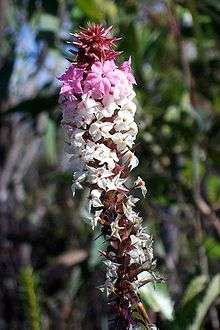Woollsia
Woollsia is a monotypic genus in the family Ericaceae. The sole species, Woollsia pungens, known as snow heath, is a small shrub found in eastern Australia, from Pigeon House Mountain in southern New South Wales north into Queensland.[1]
| Woollsia | |
|---|---|
 | |
| Blue Mountains National Park, Australia | |
| Scientific classification | |
| Kingdom: | Plantae |
| Clade: | Tracheophytes |
| Clade: | Angiosperms |
| Clade: | Eudicots |
| Clade: | Asterids |
| Order: | Ericales |
| Family: | Ericaceae |
| Subfamily: | Styphelioideae |
| Tribe: | Epacrideae |
| Genus: | Woollsia F.Muell. |
| Species: | W. pungens |
| Binomial name | |
| Woollsia pungens | |
Taxonomy
Antonio José Cavanilles described the species as Epacris pungens in 1797, from material collected in the Sydney district.[2] Victorian state botanist Ferdinand von Mueller proposed the new genus Woollsia in 1873,[3] though did not publish its new binomial name until 1875.[4][5] The genus name honours William Woolls.
Genetic analysis shows that it is an early offshoot of a lineage that includes Lysinema ciliatum and the genus Epacris.[6][7]
'Snow heath' is a common name.[8]
Distribution and habitat
In the Sydney region, Woollsia pungens grows in heathland with such species as saw banksia (Banksia serrata), mountain devil (Lambertia formosa), grasstree (Xanthorrhoea resinifera), and open sclerophyll forest under such trees as Sydney peppermint (Eucalyptus piperita), scribbly gum (E. haemastoma) and red bloodwood (Corymbia gummifera).[9]
Ecology
Plants are thought to live 10–20 years in the wild. They are generally killed by bushfire, with new seedlings growing from seed stored in the soil.[9]
Cultivation
In cultivation, it grows best in a part-shaded spot with good drainage and ample moisture. It can be propagated by cuttings or seed.[8]
References
- Powell, J.M. "Genus Woollsia". PlantNET - New South Wales Flora Online. Royal Botanic Gardens & Domain Trust, Sydney Australia. Retrieved 17 October 2008.
- Cavanilles, Antonio J. (1797). Icones et Descriptiones Plantarum (in Latin). 4. Madrid: Ex Regia Typographia (Eius operas dirigente Petro Iuliano Pereyra). p. 26.
- Mueller, Ferdinand von (1873). Fragmenta phytographiæ Australiæ (in Latin). 8. Melbourne: Auctoritate Gubern. Coloniæ Victoriæ, Ex Officina Joannis Ferres. p. 55.
- Mueller, Ferdinand von (1875). Fragmenta phytographiæ Australiæ (in Latin). 9. Melbourne: Auctoritate Gubern. Coloniæ Victoriæ, Ex Officina Joannis Ferres. p. 48.
- https://biodiversity.org.au/nsl/services/search?product=apni&tree.id=3029293&name=Woollsia+pungens&inc._scientific=&inc._scientific=on&inc._cultivar=&inc._other=&max=100&display=apni&search=true
- Quinn, Christopher J.; Crowden, Ronald K.; Brown, Elizabeth A.; Southam, Michael J.; Thornhill, Andrew H.; Crayn, Darren M. (2015). "A reappraisal of the generic concepts of Epacris, Rupicola and Budawangia (Ericaceae, Epacridoideae, Epacrideae) based on phylogenetic analysis of morphological and molecular data". Australian Systematic Botany. 28: 63. doi:10.1071/SB13009.
- Johnson, Karen A.; Holland, Barbara R.; Heslewood, Margaret M.; Crayn, Darren M. (2012). "Supermatrices, supertrees and serendipitous scaffolding: Inferring a well-resolved, genus-level phylogeny of Styphelioideae (Ericaceae) despite missing data". Molecular Phylogenetics and Evolution. 62 (1): 146–158. doi:10.1016/j.ympev.2011.09.011. PMID 21967784.
- Walters, Brian (February 2017). "Woollsia pungens". ANPSA - Guide to Australian Plants. ANPSA. Retrieved 18 July 2019.
- Benson, Doug; McDougall, Lyn (1995). "Ecology of Sydney Plants 3: families Cabombaceae to Eupomatiaceae" (PDF). Cunninghamia. 4 (2): 217–429 [390]. Archived from the original (PDF) on 23 June 2014.